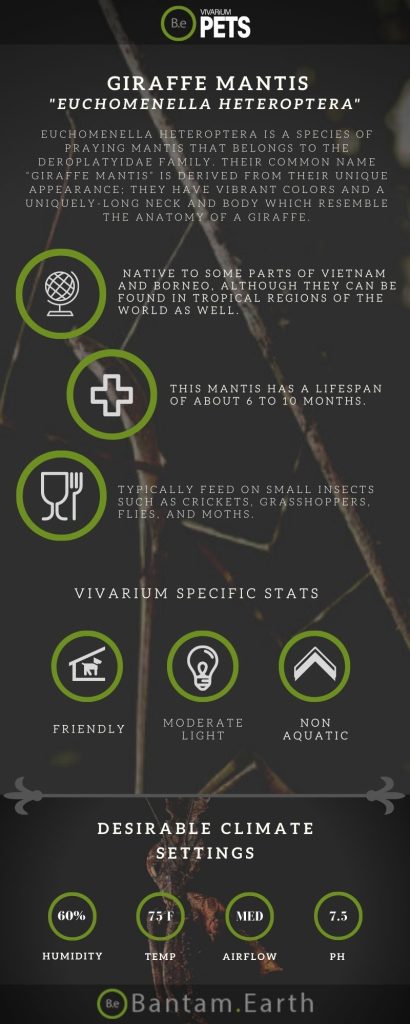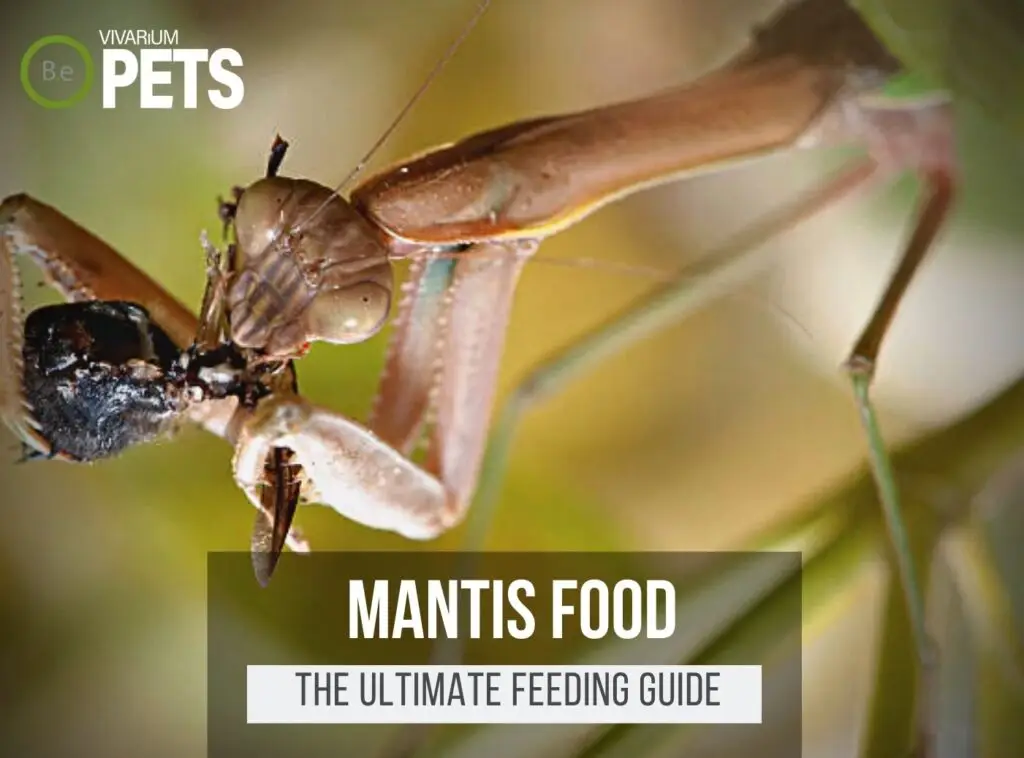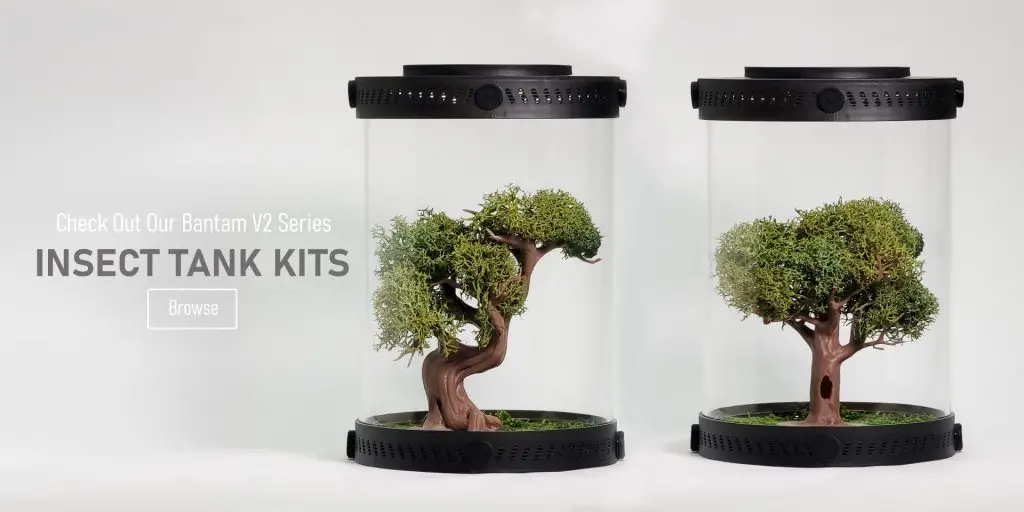Welcome to the comprehensive Euchomenella heteroptera care guide!
If you’re looking to bring this incredible species into your home, then you’ve come to the right place.
In this guide, we’ll be covering the environmental requirements, what and how to feed your Giraffe Mantis, breeding tips, and a few steps to keep your pet praying mantis healthy.
With the right care, you’ll be able to provide a safe and secure habitat to E. heteroptera. So let’s get started!
| Characteristics: | |
|---|---|
| Common Name | Giraffe Mantis |
| Family Name | Deroplatyidae |
| Scientific Name | Euchomenella heteroptera |
| Use | Pets |
| Temperament | Non-aggressive |
| Lifespan | 6 to 10 Months |
| Diet | Insectivore |
| Adult Size | 3 to 4 in |
| Breeding Type | Egg Layer |
| Care Level | Moderate |
| Minimum Tank Size | 5 to 10 Gallons |
| pH | 7.0-8.0 |
| Hardness | Moderate |
| Temperature | 70-77°F |
Table Of Contents:
ToggleWhat Are Giraffe Mantis?
Euchomenella heteroptera is a species of praying mantis that belongs to the Deroplatyidae family.
Their common name “Giraffe Mantis” is derived from their unique appearance; they have vibrant colors and a uniquely long neck and body which resemble the anatomy of a giraffe.
They originate from tropical countries across numerous parts of Vietnam as well as Borneo and are quite popular in the pet trade.
What Does Giraffe Mantis Look Like?
Euchomenella heteroptera is an impressive sight, measuring up to 4” in length with spectacular contrasting hues of dark green to yellow.
This variation of color is part of what makes them so alluring.
Most of the species consist of brownish shades on the wings, thorax, and legs with striking yellow patterns on their abdomens.
Notably, their body looks like giraffes due to their long, slender physique.
They have two large eyes on either side that give them a glaring stare that can mesmerize anyone.
In addition, the wings of the praying mantis are typically long and thin.
All in all, the Giraffe Mantis is one of the most stunning insects to behold.
Benefits Of Using Giraffe Mantis
Euchomenella heteroptera is an increasingly popular choice for vivariums due to its striking looks and fascinating behaviors.
These impressive-looking mantes are perfect for those looking to add a unique and interesting element to their tank environment.
Not only are these creatures beautiful to look at, but they are also beneficial for the tank’s ecosystem.
They are voracious predators that help to keep other invertebrates such as flies, aphids, and caterpillars under control.
Additionally, their camouflage-like coloring helps to keep the tank looking natural and free of clutter.

Giraffe Mantis Facts
Giraffe Mantises are a beautiful species of praying mantises native to the tropical rainforests of Southeast Asia.
They have an average lifespan of almost a year, eat a variety of small insects, and have a passive temperament.
Breeding is relatively easy for experienced owners, but temperature and humidity must be closely monitored throughout the process.
Habitat
Euchomenella heteroptera is native to some parts of Vietnam and Borneo, although they can be found in tropical regions of the world as well.
They live in both wet and dry habitats, sometimes around humans and sometimes in more isolated and open sites.
They also can climb so they can be found in trees and other high areas.
These animals prefer warmer temperatures, generally between 70 and 77 degrees Fahrenheit.
They can be found in both forests and deserts, depending on where they originated from.
In their habitats, the mantis live in leaf litter and beneath stones or rocks and hide under vegetation.
These animals have also adapted to live in human-made habitats such as gardens, landscapes, and other areas of human disturbance.
They can camouflage as well, which helps them to escape their predators.
Create the perfect home for your mantis with our Customizable Mantis Enclosure Kits, designed to meet all their habitat needs.
Diet
In their natural habitat, Euchomenella heteroptera are efficient hunters and typically feed on small insects such as crickets, grasshoppers, flies, and moths.
Wild Giraffe Mantises will also feed on decomposing fruit and flowers, so it is good to include those in their diet too.
Temperament
Giraffe Mantises are naturally skittish and defensive around both humans and other animals.
Though they aren’t likely to become aggressive when they feel threatened they may lash out.
It is good practice to leave them to their own devices and avoid handling them to keep them calm.
When stressed, they may also curl their large front arms which tend to look quite intimidating.
To help your Giraffe Mantis relax, make sure that its environment is room temperature and that it can hide.
When given the opportunity, E. heteroptera may become comfortable enough to take food from the hand but otherwise may prefer to stay away from human contact.
With other animals, it’s best to keep them separate as your Giraffe Mantis may view them as potential predators.
While they aren’t known to act aggressively toward other animals, it is good to prevent a potentially stressful situation by avoiding contact between your praying mantis and other pets.
Lifespan
Euchomenella heteroptera has a relatively short lifespan of about six to ten months.
A significant portion of this time is spent in the nymph stage, which is when the insect molts and grows in size.
Once they reach maturity, they will breed and lay eggs before dying.
The life cycle of the Giraffe Mantis is fairly straightforward.
Once they hatch from their eggs, they will go through five stages of growth known as instars.
During each instar, the mantis sheds their exoskeleton and grows in size.
Each instar takes several weeks to complete until the mantis reaches adulthood.
Once the mantis reaches maturity, they will begin to seek out a mate and start the breeding process.
A female mantis can lay up to several dozen eggs at a time, contained in a hard casing known as an ootheca.
This casing will then be hidden within a hollow piece of wood or in the soil.
The eggs can take up to two months to hatch, depending on the temperature and humidity of the environment.
Once they have hatched, the nymphs will go through the instar stages again until they reach maturity.
Breeding
Euchomenella heteroptera mates and reproduces through sexual reproduction.
For mating to be successful, male Giraffe mantises will court the female by raising their antennae as a warning and then tapping and vibrating their wings, paired with a strange movement of the head.
If the female is receptive, she will stay in the same location.
The males will use the claspers on the female and the mating process will take about ten to twenty minutes.
Once mating is complete, the female will lay her ootheca.
Where To Find Giraffe Mantis
Finding an Euchomenella heteroptera for sale or in the wild can be a challenge since they are a relatively rare species.
If you are looking to buy a Giraffe Mantis, your best bet is to look through various online retailers.
This species is usually sold as an egg sac or as a live adult or juvenile.
E. heteroptera can also be found in the wild, though they are generally located in tropical regions of the world.
These regions typically feature dense rainforests and swamps that are well-suited for the mantis species.
If you are fortunate enough to find a Giraffe Mantis in the wild, make sure that you are respectful and do not disturb their habitat.
Giraffe Mantis Care
Caring for Euchomenella heteroptera requires the right environment and food to keep them healthy.
The environment should be warm and humid with plenty of ventilation, and the mantis should be fed a variety of live foods.
Breeding should take place in the spring when the temperature reaches the desired level, and common diseases should be noted and treated according to the symptoms.
Tank Requirements
When it comes to tank requirements for a Giraffe Mantis, the ideal environment would be a well-ventilated terrarium, with temperatures ranging from 70°F to 77°F.
The pH levels should be around 7.0 to 8.0, and the hardness between 4.0 and 8.0.
When it comes to the terrarium substrate, a 5-8cm layer of coconut coir, sphagnum moss, or potting soil is preferable.
Terrarium lighting is not necessary for your Euchomenella heteroptera, although it may help keep your mantis warm on cooler days.
Avoid using fluorescent lights as it may result in term toxicity and dehydration.
What Does Giraffe Mantis Eat?
Feeding a Giraffe Mantis is an essential part of caring for them. It’s vital to research what they eat, as their diet is very particular.
The most common foods that they will accept are small insects (such as flies, crickets, and mealworms), small spiders, and ground-up fruits and vegetables.
In general, they should be fed one to two times per week.
It’s crucial to make sure that the food is fresh and free of pesticides.
To avoid overfeeding, remove any uneaten food after a few hours.
Before feeding, spread the food items on the floor near the mantis and watch as it slowly samples each item.
Ensure your mantis are receiving a balanced diet – try to give them a variety of bugs to feed on.
After each feed, discard any leftover food and clean up the mantis enclosure thoroughly.
Keep in mind that they are also capable of starving themselves, so make sure their food dish is always filled. Good luck!
If you’re looking for a more detailed approach to feeding these critters, be sure to check out my ultimate DIY Praying Mantis food guide. I give a more in-depth explanation of the best foods and my favorite recipe.
Best Tankmates For Giraffe Mantis
If you’re looking for tankmates for your Euchomenella heteroptera, then you have a few options.
One of the best tankmates to keep with the Giraffe Mantis is the spiny devil stick insect.
This species of stick insect is a herbivore and can survive off the same plant matter as your Giraffe Mantis.
These insects can grow to quite a large size and should provide a natural balance in the tank for your pet mantis.
Another beneficial tankmate to consider is the hissing cockroach.
Hisers are omnivorous scavengers, meaning they’ll eat almost anything that meets their nutritional requirements.
These cockroaches can also provide some interest in the tank as they hiss and climb around the enclosure’s décor.
When choosing tankmates for E. heteroptera, it’s good to always consider the safety and well-being of all animals in the enclosure.
With the right research, you should be able to create a safe and interesting habitat that works for all tankmates.
Conclusion
Overall, if you are looking for an interesting and unique pet, look no further than Euchomenella heteroptera!
This species requires a bit of extra care to remain healthy and strong, but with the help of this guide, you can learn how to properly care for your pet mantis and ensure they have a long and healthy life.
Although raising a Giraffe Mantis requires extra effort, it is well worth the reward of having a fascinating pet. Good luck with your new pet!
Create the ideal habitat for your praying mantis with our species-specific soil mixes and Insect Enclosure Kits. These products provide everything you need for a thriving Mantid habitat.
Frequently Asked Questions
A giraffe mantis (Euchomenella heteroptera) is a species of mantis that is native to the southern and eastern regions of Africa. It is distinguished by its long neck structure which resembles the neck of a giraffe. The colouration of the species is usually brown tinged with yellow or orange spots. They have long front legs with spined tibiae and long antennas. They feed primarily on small insects.



